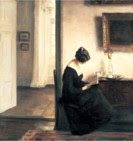

I read most of Daphne Du Maurier’s novels as a teenager in the 70s.
Rebecca was my favourite, of course. I loved Laurence Olivier in the Hitchcock movie (even though they had to change a few plot points to make Max less culpable) & I read the book over & over again. I still have a few of the novels to go & I’ve only read one of her volumes of short stories. I borrowed most of her books from my local library in the old yellow Gollancz hardbacks.
I was very pleased when Virago started reprinting Du Maurier so I could catch up on a few titles I’d never read, including some of the non-fiction books she wrote about her family. I’d also like to find time to reread Margaret Forster’s biography of Daphne. If you click on the photo, I hope you can see the titles of my Du Mauriers more clearly. The 3rd book down with the very faded spine is
The Rebecca Notebook & other memories. After I took the photo I remembered my copy of
Vanishing Cornwall which is on another tbr shelf.
My Cousin Rachel was another of the books I read back then. When
Cornflower announced it as her next Book Club choice, I was inspired to take my copy down from the shelf for a reread.
My Cousin Rachel made a great impression on me as a teenager. I remember being unsure who to believe – Philip, the young naive narrator, or beautiful sophisticated Rachel. This time, I was much more firmly on Rachel’s side, although there’s enough doubt in my mind about some of her actions & motivations to still be tantalisingly unsure. That’s the beauty of Du Maurier’s skill as a writer. The balance sways one way & another without ever coming to rest completely. As Philip’s godfather tells him,
There are some women, Philip, good women very possibly, who through no fault of their own, impel disaster. Whatever they touch somehow turns to tragedy. I don’t know why I say this to you, but I feel I must.
The story is one of jealousy & love. Philip Ashley has been brought up by his cousin, Ambrose, a middle-aged bachelor, at their family home in Cornwall. Ambrose travels to Italy for his health, &, while he’s there, he meets a distant relation, the beautiful Rachel, Countess Sangaletti. Philip is amazed to hear that Ambrose & Rachel have married & they are living in her villa in Naples. Philip is jealous but soon his jealousy turns to concern as Ambrose’s letters become mysterious. There are hints of poison & madness. Ambrose’s final letter, delivered as Philip is already on his way to Naples to find out what is going on, is just a few scribbled lines.
For God’s sake, come to me quickly. She has done for me at last, Rachel, my torment. If you delay, it may be too late.
Philip arrives in Naples to the news that Ambrose is dead & Rachel has already left Naples, no one knows her destination. The scenes in Italy are beautifully done. Philip, young, stiff, very English, has travelled from cold, windswept, provincial Cornwall to warm, sensual, cosmopolitan Naples. He’s out of his depth. Shocked by the news of Ambrose’s death, suspicious of the servants at the villa & hostile to Signor Rainaldi, Rachel’s friend & lawyer, he is determined to find out the truth. Heartbroken, he returns to England to hear from his godfather, Nick Kendall, that Rachel has arrived in England & wants to visit. Ambrose hadn’t changed his will on his marriage so Philip has inherited everything. Rachel has nothing. Philip is immediately suspicious of her motives.
Once she arrives, however, he is beguiled by Rachel. She captivates everyone she meets – apart from Philip’s childhood friend, Louise Kendall, who is jealous in her turn. Philip becomes increasingly infatuated with Rachel, culminating with his desire to give her the property outright when he becomes his own master on his 25th birthday. But there are still questions & doubts. Ambrose’s family has a history of brain fevers, maybe madness. His illness in Italy was similar to a brain fever & his paranoid letters could have been a result of this. Rachel is an enthusiastic & knowledgeable gardener & brews herbal tisanas & remedies. Did she poison Ambrose? If she knew he hadn’t changed his will, there would be no point. But, did she know? She presents herself as a heartbroken widow, she plays the part well, but is she just trying to influence Philip to give her an allowance? Then, stories begin to circulate of the life she led with her first husband, a dissolute gambler who was killed in a duel. By now, Philip is in thrall to Rachel & desperate to marry her. The scene is set for the final tragedy.
I shall become a Justice of the Peace, as Ambrose was, & also be returned, one day, to Parliament. I shall continue to be honoured & respected, like all my family before me. Farm the land well, look after the people. No one will ever guess the burden of blame I carry on my shoulders; nor will they know that every day, haunted still by doubt, I ask myself a question which I cannot answer. Was Rachel innocent or guilty? Maybe I shall learn that too, in Purgatory.
This is a fantastic read, full of suspense. The romance of Cornwall, an unreliable, impulsive narrator, an enigmatic heroine & those unanswered questions. Du Maurier was a superb storyteller & this is one of her most successful novels. If you haven’t already read it, you’re in for a treat.
































